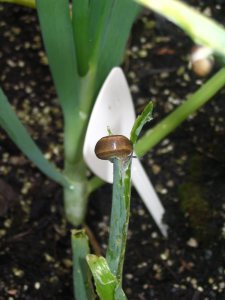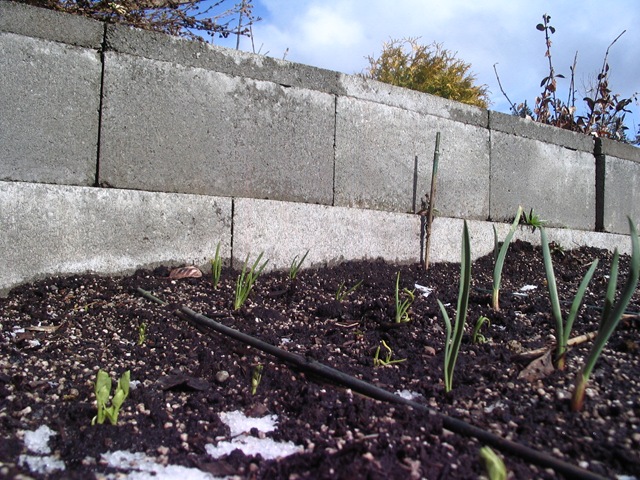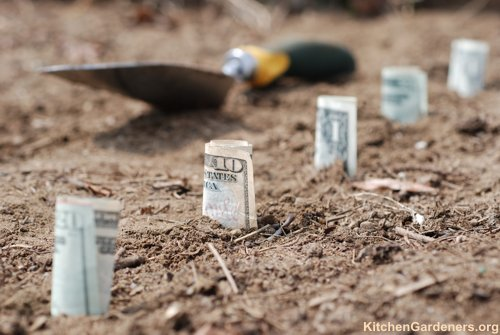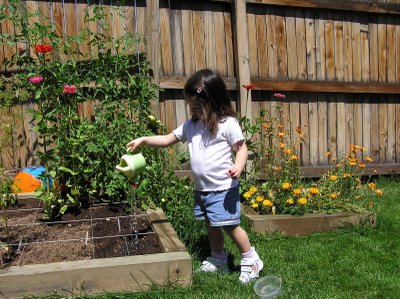Growing in dirt outside
15.2 years ago cilantro, cucumbers, garlic bulbs, indoor growbox, onions, outdoor seed starting, peas, tomato
I haven’t done many posts in a while about regular old gardening in actual dirt so figured a good time to do an update. Though I enjoy indoor seed starting in my LED grow box and computerized grow box, some plants need to be started outdoors. Today my daughters and I planted the last these plants for fall outdoor planting.
A few weeks ago, we planted garlic, onions, spinach, and peas which are doing well. I love growing these plants no matter how late your spring comes these plants are hardy they are pretty hard to kill off.
Today we planted carrots, lettuce, and cilantro leaving a little space left to do some successive cilantro planting in a couple weeks to ensure I have enough for salsa by the time the tomatoes are ready this summer.
Speaking of tomatoes, they along with jalapeño peppers, and cucumbers (actually flowering) are doing great in the computerized grow box. In the LED grow box I have pumpkin, Black Eyed Susan, small sunflowers, and Purple Coneflowers using Grodan Gro-Blocks.
Nice to finally see some stuff in the ground though still hoping the weather gets better before my cucumbers try to escape the grow box.
Tags: cheap, cilantro, garden seeds, garlic bulbs, growbox, led, outdoor plants, pepper plants, salsa garden, tomato plants, vegetables
The most profitable plants in your vegetable garden
15.4 years ago cheap, cilantro, garlic bulbs, organic, seedling, seeds, vertical gardening, winter garden
Many vegetables can be expensive to purchase by growing the most expensive vegetables in your garden and buying the least inexpensive vegetables at your grocery store you can easily help drop your food budget. This especially important for people like me with very limited space to grow everything that I consume.
It may be impossible to put a price on the satisfaction of bringing in a basket of produce fresh from your garden. As well as the enhanced flavors from having truly fresh produce from your garden compared to that of your local supermarket. Though when I was harvesting my potatoes this summer with my daughter I did have the thought, Would it have been smarter for me to grow something else in this space? I estimate out of the 4-5 square feet I used for these plants I probably got about $4-5 worth of potatoes.
I did a little research first to determine yields of various plants per square foot and secondly what the value (organic supermarket prices USD) of the yielded produce at harvest. Given I am a city dweller with a fairly small footprint for my vegetable garden (about 30-35 square feet) making decisions on what to buy at the supermarket and what to grow in the garden may be a huge money saver with just a few dollars invested in some seeds for your vegetable garden
Now from the results below you can see the winners for the most produce value per square foot are many of the leafy green vegetables/herbs (cilantro, lettuce, chives, dill, Swiss chard) next comes many of the larger vine plants (tomatoes, squash, pumpkins, peas) with many of the root plants taking up the rear. Now much of this makes sense where many of the vine plants grow on trellises and are allowed to spread, which I guess is sort of cheating the square foot rule but I will let it slide. Compared to the root plants whose production is entirely dependent on the space allowed in square footage they have to grow as well as these are normally inexpensive produce items to begin with.
| Vegetable | USD Value/SF |
| Cilantro | $ 21.20 |
| Arugula-Roquette | $ 20.92 |
| Green Salad Mix | $ 17.55 |
| Chives | $ 16.40 |
| Dill | $ 16.40 |
| Lettuce | $ 16.20 |
| Tomato, Cherry, small & medium | $ 15.57 |
| Turnip | $ 9.90 |
| Tomato, large | $ 9.50 |
| Squash, Winter | $ 8.40 |
| Tomatillo | $ 8.00 |
| Cucumber | $ 7.74 |
| Basil | $ 6.63 |
| Radish, Red | $ 6.22 |
| Pumpkin | $ 6.20 |
| Chard, Swiss | $ 6.14 |
| Celery | $ 6.00 |
| Squash, Summer | $ 5.96 |
| Choi | $ 5.70 |
| Peas, Snow | $ 4.50 |
| Pepper, Jalapeno | $ 4.50 |
| Squash, Summer, Zucchini | $ 4.17 |
| Onion, Bunching | $ 4.14 |
| Pepper, Bell | $ 3.60 |
| Brussels Sprouts | $ 3.59 |
| Carrots | $ 3.56 |
| Rhubarb | $ 3.25 |
| Squash, Winter, Butternut | $ 3.20 |
| Kale | $ 3.07 |
| Grass, Lemon | $ 3.00 |
| Peas, English | $ 3.00 |
| Onion, Bulb | $ 2.63 |
| Radish, White | $ 2.60 |
| Bean, Bush | $ 2.51 |
| Peas, Edible Pod | $ 2.50 |
| Artichoke, Globe | $ 2.40 |
| Cabbage, Chinese Napa | $ 2.24 |
| Squash, Winter, Delicata | $ 2.10 |
| Spinach, Spring/Fall | $ 1.80 |
| Leeks | $ 1.75 |
| Potatoes | $ 1.50 |
| Parsnips | $ 1.50 |
| Garlic | $ 1.37 |
| Squash, Summer, Yellow | $ 1.34 |
| Parsley | $ 1.31 |
| Corn | $ 1.25 |
| Squash, Winter, Acorn | $ 1.20 |
| Squash, Winter, Hubbard | $ 1.20 |
| Eggplant | $ 1.10 |
| Greens, Mustard | $ 1.10 |
| Rutabaga | $ 1.00 |
| Beet | $ 0.89 |
| Cabbage, Savoy | $ 0.80 |
| Broccoli | $ 0.80 |
| Kohlrabi | $ 0.75 |
| Cauliflower | $ 0.60 |
| Broccoli, Chinese | $ 0.60 |
| Cabbage | $ 0.50 |
Sources: http://www.mcgoodwin.net/pages/ppatch.html for plant yield information, http://shop.safeway.com for current produce prices
Now even with this information I will still plan on growing some onions and garlic since I more than likely would be forced to use dehydrated alternatives due to being too lazy to drive to the supermarket to buy fresh varieties. Though I may be adding some more herbs/greens to my garden this year.
One important thing to remember is you still have to eat the vegetables, throwing $20 worth or arugula or cilantro into the compost bin is not exactly a sound investment. You can also get higher yields by growing vertically, but don’t forget those tall plants produce a larger shadow so you may still need some extra ground space to support these alternate growing methods.
So go out and get some cheap vegetable seeds (or in many cases free) and plant some profitable vegetables in your backyard/patio garden this spring.
Tags: cilantro, compost, garlic bulbs, herb garden, organic vegetables, outdoor plants, pepper plants, tomato plants, vegetables
Hey, those cucumbers look like pickles
15.7 years ago cucumbers, summer

That was a statement my oldest daughter (6 years old) made which I must admit I am pretty sure I was much older before I had that thought. Seemed like a good opportunity for teaching the kids were pickles come from and a great excuse to make some sweet summer pickles. While heading out the door to get some spices we were lacking my wife told me, "these better not be $20 pickles." I have some history here, taking that advice I only came back with just mustard seed and decided to improvise the rest, here is what I came up with.
Cheap Vegetable Gardener’s Sweet Summer Pickle recipe
- 1 cucumber
- 1 clove garlic
- 1/2 cup apple cider vinegar
- 1 cup water
- 3 T sugar
- 1/2 tsp salt
- 1/4 tsp pepper flakes
- 1/4 tsp cloves
- 1/8 tsp cinnamon
- 1/4 tsp coriander (mine were still a little green from garden)
- 1/4 tsp mustard seed
- 1/4 tsp black pepper
Directions: Pretty easy, just cut the cucumber into slices 1/4 in thick and add all ingredients to sealable container, shake well, and place in refrigerator. Wait at least 3 days and eat. Once empty just add more sliced cucumbers and repeat.
Tags: cheap, garden seeds, garlic bulbs, pepper plants, vegetables
How to water your garden
15.9 years ago water
Many people may look at the topic of this post and think how basic a topic this is. The reality is proper watering is the most difficult part of growing a garden. The challenge ensures in the fact that roots need to stay moist, but not too moist since roots do not grow in the soil but in the space (air) between it so with too much water your can actually drown your plants. What makes this even more complicated is the visual signs of overwatering are the exact same as under watering with wilted leaves and yellowish color. Your immediate reaction is, “I am not watering enough” so you water more drowning the plants even more and eventually leading to their demise. Even if your plants look ok you still could be affecting your harvest. For example, if you overwater your tomatoes they will be green enjoying the perfect environment and never get around to creating some blossoms which will result delicious fruit. At the same time under watering your leafy plants can result in bitter tasting lettuce or even worse make them go right to seed and get very little or no harvest in plants like cilantro and spinach.
How do I know how much I need to water? Unfortunately the answer to this questions is “It depends” first you need to determine the structure of your soil (sandy, loam, or clay) If you do not know the structure of your soil you can to a simple glass jar soil test Sandy soils allow water to drain very quickly so you will need to water about three times as often as clay soil and about twice as much as loamy soil. If you live in a dry climate or just have a couple really hot weeks in your not so dry climate you will probably need to water at least every day to keep your plants healthy regardless of your soil structure.
The next factor is how deep do you want the water? It is important to make sure water actually gets to where the roots are, which has been the demise of my first years of tomato plants. Where I watered the surface but the soil was bone dry a several inches below the surface which I realized once I pulled out the dead plants. So first know your plants root system if you are growing deep root plants such as tomatoes, corn, cucumbers, peppers, beans, squash, eggplant, or melons you will need to water longer to ensure that the water makes it down to their deep root system but you can water less often since you will not lose as much to evaporation. If you are growing lettuce, spinach, carrots, radishes, peas, garlic, onions, cabbage, cilantro, or broccoli you need to water less but more frequent to ensure the soil stays most.
Now hopefully you have a better idea when and how much to water, here are some tips from Mel Bartholomew from “Square Foot Gardening” books/videos/PBS series. His first tip is “Don’t water from overhead” since first you waste water due to evaporation but you also get you leaves wet which can lead to disease and frying your plants. If you must water from above if you have a very large garden or if you are away from your garden and need to automate the process, he insists this is done first thing in the morning. If you are like me and enjoy sleeping at dawn you may want to look into his cup and bucket watering method where you fill up a couple of 5 gallon buckets and let them sit out in a sunny spot. You get the benefit of the sun warming the water to prevent shocking the plants with cold tap water especially on a streak of hot summer days. Another benefit is gives time for the tap water to purify itself a little before applying to plants. Once you have your bucket of water the concept is pretty simply just find a nice container (I normally raid my recycling bin) and scoop water out of the bucket and pour it directly under the leaves of the plant with little water waste and the delicate leaves remaining completely dry. This is also helps you measure exactly how much water you are giving to each plant which you can adjust as needed. You can also get some of the same benefits by using a trickler hose of a bubbler attachment if your back can not take the weight of packing around 5 gallon buckets full of water.
Now if after all of this explanation I haven’t scared you too much in fear of not watering too little or too much here are a couple more tips to make your watering more successful.
- Order on a consistent schedule: It is easy to forget the last time you water and watering a few days late or early can have significant effects on your harvest.
- Have a test hole: Normally there is somewhere in your garden where something is not currently growing after doing you normal watering dig into that hole and see how deep your watering is actually getting.
- Finger test: By sticking your finger into your soil if it comes back dry you probably need to water
- Get a water meter: If you want something a little more scientific you can always pick up a cheap water meter for less than $10 which can give you a measurement several inches underground
Tags: cheap, cilantro, garden seeds, garlic bulbs, led, outdoor plants, pepper plants, tomato plants
Garden teriyaki sauce recipe
15.9 years ago garlic bulbs, growing challenge

This is the first year I have grown garlic inspired by the Growing Challenge so now I want to find some good uses for this new addition. For Independence Day we are having a typical BBQ (teriyaki chicken burgers) and we ran out of teriyaki sauce seemed like a logical thing to attempt. Must say the improvised recipe was really easy and tasted much better than the stuff we got from the store (much less salty) I have kids so I only used a small pinch of red pepper flakes but with those with a taste for extra spice recommend adding at least a half a teaspoon.
Garden teriyaki sauce recipe
- 1 tsp olive oil
- 1 tsp of chopped or pressed garlic
- 1 tsp of fresh grated ginger (1/2 tsp powdered ginger)
- 1/2 cup soy sauce
- 1/2 cup brown sugar
- 1/4 cup honey
- 1 cup water
- red pepper flakes (to taste)
Directions: Warm oil is sauce pan at medium heat and add garlic and ginger to oil. Stir for 2 minutes and add remaining ingredients. Reduce heat and stir until sugar dissolves. Make 12 ounces of teriyaki sauce.
Tags: garlic bulbs, pepper plants
Slugs eating my garlic
16 years ago garlic bulbs, slugs

The word is slugs are supposed to hate garlic, guess no one told this guy. The reality is they do not like the bulb underground apparently the garlic leaves are delicious. Appears that I need to step up my war with the slugs.
Tags: cheap, garlic bulbs, vegetables






